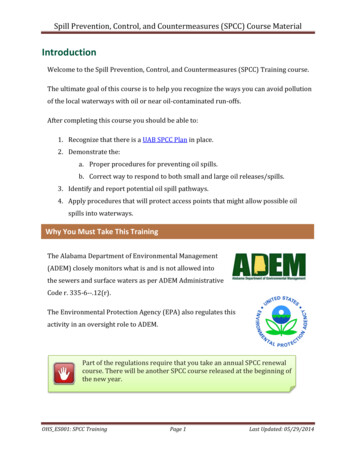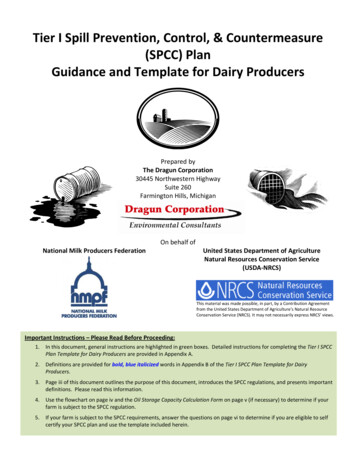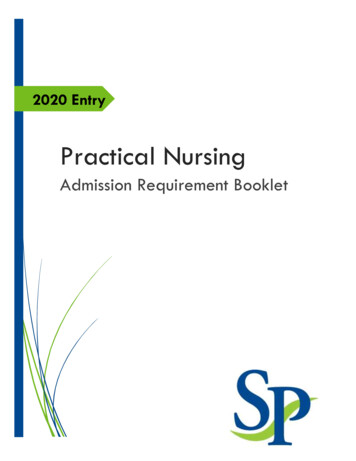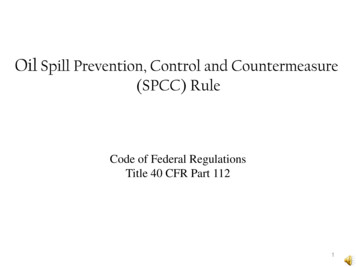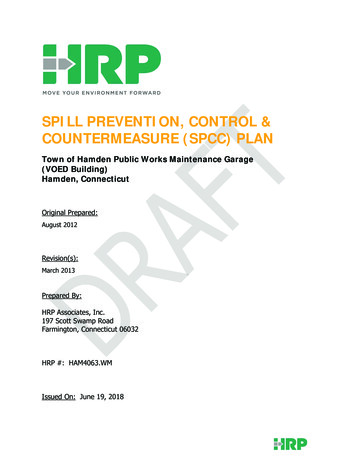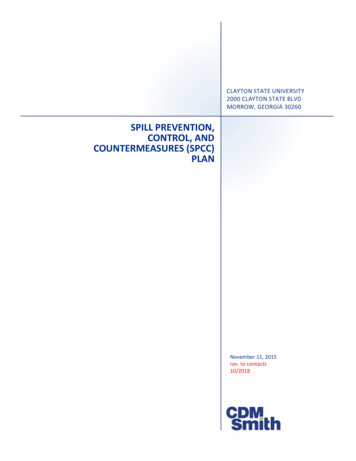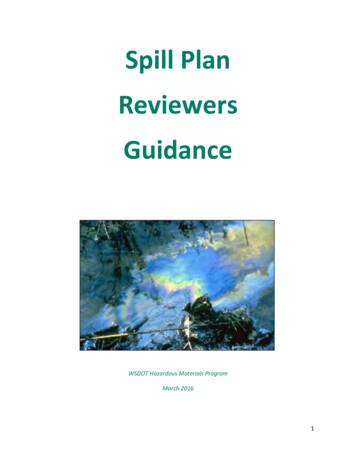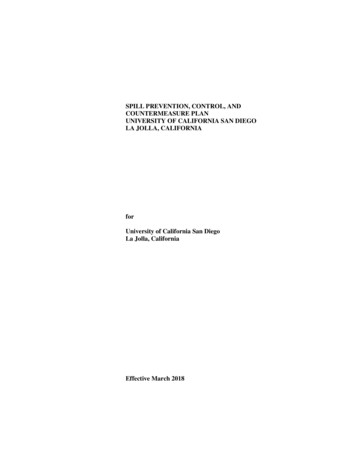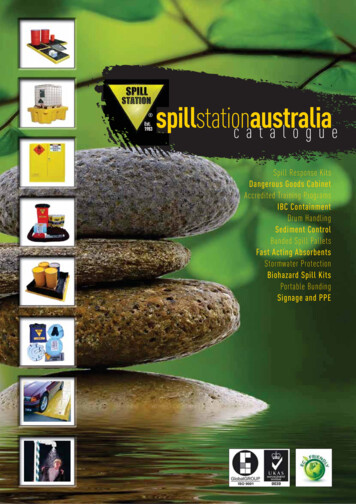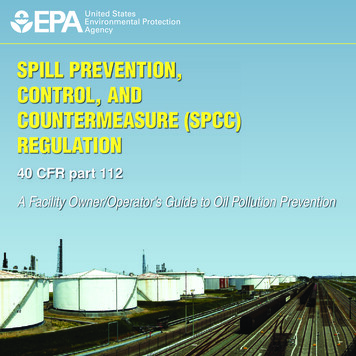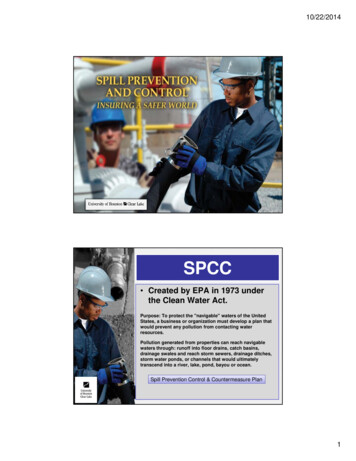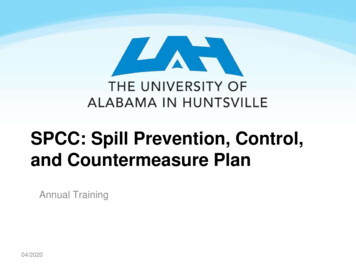
Transcription
SPCC: Spill Prevention, Control,and Countermeasure PlanAnnual Training04/2020
Why are we here? CFR Title 40, Part 112The regulation requires owners or operatorsof governed facilities to implement andmaintain a Spill Prevention Control andCountermeasure Plan.The Plan must be reviewed and evaluatedevery 5 years.Ours was written in November of 2016 andwe will need to prepare a new one next year.
Can anyone amend the plan? It has to be a professional engineer orP.E.
Where is the plan kept? It must be kept at the facility unless the facility experiences one ofthe following: A single oil spill of more than 1000 gallons into naturalwaterways or adjoining shorelines OR Two oil discharges, more than 42 gallons each, which occurwithin any consecutive 12 month period. If either of these events occur, the facility must report the triggeringevent to the applicable local, State, and Federal Regulators alongwith a copy of the plan within 60 days. The plan and a spill report should be sent to EPA Region VII inAtlanta, GA if this occurs.
Purpose of the SPCC Rules To develop plans designed to prevent OilDischarges from reaching the navigablewaters of the U.S. and adjoiningshorelines.
For the purpose of the plan, oil is. . . Petroleum and non-petroleum based oils Crude Oil Refined Products Animal Fats Vegetable Oils
How does the regulation determinevolume of oil? The applicability of the regulation isdetermine by oil storage capacity – notthe actual inventory. Only containers of oil with a capacity of 55gallons or greater are counted. Equipment oil reservoirs are not countedunless the capacity is greater than 55gallons.
Intent of the Standard It’s never wrong to go ahead and report toOEHS or even the regulators. But keep inmind the intent of the standard – to preventoil spills and to be prepare for effectiveaction if spillage does occur.In short, it’s more important to stop the oilfrom spreading and get it cleaned up thananything else. Go ahead and block anystorm drains or other access to water first,then call.
What is a Navigable Waterway? Loaded question.Surface waterways – streams, creeks, river,lakesWetlands adjacent to a navigable waterwayCan be intermittent streams. Must flow atleast seasonally.Defined flow pathway to truly navigablewaters of the U.S. is a good start in thedetermination – don’t assume.
Applicable to UAH UAH is a non-transportation related, onshore facilityengaged in storing and consuming oil and oilproducts, which due to its location could reasonablybe expected to discharge oil in quantities that may beharmful, into or upon the navigable waters of the U.S.or that may affect natural resources belonging to theU.S.More than 1,320 gallons are stored above ground.There is 42,000 gallons capacity for storageunderground.
Site Plan, FacilityDrainage, and PotentialPollution SourcesFacility Location Map
Facility Security and Lighting The UAH campus is generally open to thepublic.All areas where valves, pumps, or othercontrol devices are located are secured bydoors or gates that are kept locked when notin use by authorized personnel.Sufficient lighting is provided throughout thefacility to allow for the visual discover ofspills that could occur at any time during any24-hour period.
Bulk Storage Container Design Above ground bulk liquid storagecontainers at this facility consist of paintedsteel tanks containing diesel fuel. The materials and construction of theliquid storage containers are compatiblewith the materials stored and theconditions of storage such as temperatureand pressure.
General Facility Data All bulk storage containers at the facilityare manually filled and continually visuallymonitored during filling operations. This procedure is used in lieu of a highlevel alarm or high level liquid pump cutoffdevices.
Bulk Storage Container TestingProcedures Visual Inspection Visual inspections are part of regular safetyhousekeeping inspections.Student Workers perform visual checksusing the checklists in the SPCC Exhibits.When any modifications are done to thetanks, integrity and leak testing is required.
Bulk Storage Container TestingProcedures (continued) Bulk Container Testing In addition to visual inspection, another testingtechnique is required. All regulated aboveground bulk storage tanks shouldbe tested at least once every 3 years for integrity. Inventory control will be utilized to provide leakdetection for all underground storage tanks.Valves and Piping should undergo visual inspection forcorrosion and leaks. Other content of loss control measures shouldinclude inventory records.
History of On-site Spill Incidentswithin last 3 years Spill at Central Plant by truck unloading diesel New system for fuel transfer was installedwhich prevents the same type of spill fromoccurring. A Front-end loader leaked hydraulic fuel ontothe parking area Corrective action would be to park thevehicle as soon as the leak is noticed anduse spill absorbent materials to isolate spillusing a catch basin if available.
Potential Spill Sources USTs ASTs Transformers Elevators Heavy Equipment
Drainage and Runoff Data Runoff from UAH campus is received bydrainage ditches or the underground stormwater collection system. The storm water is directed to the pond onthe west side of the campus and iseventually received by McDonald Creek. Should a release occur, it could most likelybe held within the pond before leaving thesite.
Contingency Plan When to report outside– Anything that can reachsurface water no matter the quantityWhen to report inside – If it exceeds one quart All spills less than one quart must be cleaned upimmediately. If the spill or release cannot be readily handled by thefacility or department, contact UAH PD at 6911 toinitiate a response action. Leave someone near thescene to communicate with responders.
What will be asked? Date and time of spillArea where spill occurredEstimated volume of spill (rationale for estimate)Did any spill leave the property?If so, where was it discharged?Water into which the spill has enteredSuspected failure that caused the spillAssessment of imminent danger to personnel or propertyDamage and injuries caused by the spillActions taken to contain, stop, remove, or cleanup spillIdentification of any local emergency units contacted
If the spill is into any body of water. UAH Policy is to immediately informADEM of the location of the spill and asmuch as is known of the extent of thesituation. OEHS and UAH PD will worktogether on the reporting required for thisplan.
Where are the spill cleanupmaterials? In the yellow flammable cabinet besidethe gas pumps. In the “Clean Shed” behind JRC. In the garage.
Review: What should the employeewho discovers the spill do? Contact 6911 if anyone is injured.Locate the source of the spill if safe to do so.Try to stop and/or contain the spill using absorbents if safe todo so.Always, notify the appropriate supervisor. If the appropriatesupervisor cannot be reached, call 256-824-2170 or 2171.Once the supervisor has the cleanup operations in progress,he/she shall then notify the Emergency Coordinator toprovide info on what has happened and what actions are inprogress.Participate in incident investigation to help prevent futurespills of a similar nature.
Spill Prevention Don’t pour oil or fuel onto the ground orinto a storm drain.If you have large amounts of wastematerial and do not have a specifiedwaste stream, please contact OEHS todevelop an appropriate waste stream.
To complete this training youmust take the Quiz.
Why are we here? CFR Title 40, Part 112 The regulation requires owners or operators of governed facilities to implement and maintain a Spill Prevention Control and Countermeasure Plan. The Plan must be reviewed and evaluated every 5 years. Ours was written in November of 2016 and we will need to prepare a new one next year.

